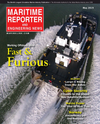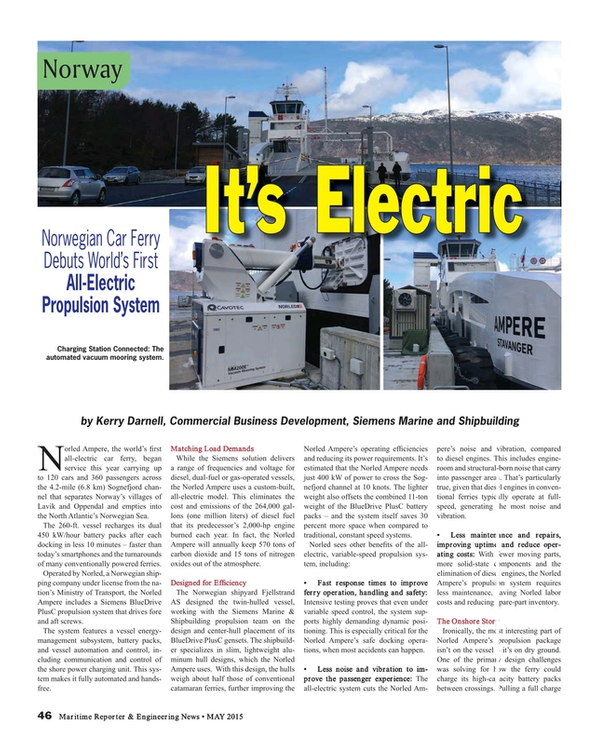
High-tech Car Ferry Debuts: It’s Electric
Norwegian Car Ferry Debuts World’s First All-Electric Propulsion System
Norled Ampere, the world’s first all-electric car ferry, began service this year carrying up to 120 cars and 360 passengers across the 4.2-mile (6.8 km) Sognefjord channel that separates Norway’s villages of Lavik and Oppendal and empties into the North Atlantic’s Norwegian Sea.
The 260-ft. vessel recharges its dual 450 kW/hour battery packs after each docking in less 10 minutes – faster than today’s smartphones and the turnarounds of many conventionally powered ferries.
Operated by Norled, a Norwegian shipping company under license from the nation’s Ministry of Transport, the Norled Ampere includes a Siemens BlueDrive PlusC propulsion system that drives fore and aft screws.
The system features a vessel energy-management subsystem, battery packs, and vessel automation and control, including communication and control of the shore power charging unit. This system makes it fully automated and hands-free.
Matching Load Demands
While the Siemens solution delivers a range of frequencies and voltage for diesel, dual-fuel or gas-operated vessels, the Norled Ampere uses a custom-built, all-electric model. This eliminates the cost and emissions of the 264,000 gallons (one million liters) of diesel fuel that its predecessor’s 2,000-hp engine burned each year. In fact, the Norled Ampere will annually keep 570 tons of carbon dioxide and 15 tons of nitrogen oxides out of the atmosphere.
Designed for Efficiency
The Norwegian shipyard Fjellstrand AS designed the twin-hulled vessel, working with the Siemens Marine & Shipbuilding propulsion team on the design and center-hull placement of its BlueDrive PlusC gensets. The shipbuilder specializes in slim, lightweight aluminum hull designs, which the Norled Ampere uses. With this design, the hulls weigh about half those of conventional catamaran ferries, further improving the Norled Ampere’s operating efficiencies and reducing its power requirements. It’s estimated that the Norled Ampere needs just 400 kW of power to cross the Sognefjord channel at 10 knots. The lighter weight also offsets the combined 11-ton weight of the BlueDrive PlusC battery packs – and the system itself saves 30 percent more space when compared to traditional, constant speed systems.
Norled sees other benefits of the all-electric, variable-speed propulsion system, including:
• Fast response times to improve ferry operation, handling and safety: Intensive testing proves that even under variable speed control, the system supports highly demanding dynamic positioning. This is especially critical for the Norled Ampere’s safe docking operations, when most accidents can happen.
• Less noise and vibration to improve the passenger experience: The all-electric system cuts the Norled Ampere’s noise and vibration, compared to diesel engines. This includes engine-room and structural-born noise that carry into passenger areas. That’s particularly true, given that diesel engines in conventional ferries typically operate at full-speed, generating the most noise and vibration.
• Less maintenance and repairs, improving uptime and reduce operating costs: With fewer moving parts, more solid-state components and the elimination of diesel engines, the Norled Ampere’s propulsion system requires less maintenance, saving Norled labor costs and reducing spare-part inventory.
The Onshore Story
Ironically, the most interesting part of Norled Ampere’s propulsion package isn’t on the vessel – it’s on dry ground. One of the primary design challenges was solving for how the ferry could charge its high-capacity battery packs between crossings. Pulling a full charge into the batteries in less than 10 minutes would put too much stress on the modest electrical grids serving the Lavik and Oppedal villages. The ferry would literally cause power outages for entire communities. An alternative charging approach was required for dockside charging at each terminal.
Siemens worked with an energy company to develop a shore-based recharging station and optimized it to work with the ferry’s battery packs. The stations incorporate a liquid-cooled version of an energy storage system. It contains modules that use advanced lithium polymer cells, with a total charging capacity of 1.46 MWh. The energy management system monitors both thruster control as well as downstream consumers on the grid. It also controls the electrical flow between the batteries and the propulsion system. The flow of energy can be controlled bi-directionally, allowing for an overhauling load to be put back into energy storage. The recharging stations slowly charge themselves from the villages’ hydroelectric power grid continuously and at a very low current draw. At each ferry landing, the shore power-charger can quickly charge the batteries while passengers and cars are unloaded and loaded.
Keeping Norway Green
Out of 60 nations ranked in the 2014 Global Green Economy Index, Norway was second only to neighboring Sweden - and not by much. Government support of innovations like the Norled Ampere ferry is a big reason why the nation can wear its green designation with pride. Although Norway is one of the world’s top oil-producing nations, it’s blessed with abundant hydropower, which provides most of the country’s electricity and helps all-electric ferries like the Norled Ampere contribute to the Earth’s environmental well being.
(As published in the May 2015 edition of Maritime Reporter & Engineering News - http://magazines.marinelink.com/Magazines/MaritimeReporter)
Read High-tech Car Ferry Debuts: It’s Electric in Pdf, Flash or Html5 edition of May 2015 Maritime Reporter
Other stories from May 2015 issue
Content
- Editorial: Across the Seas & Around the World page: 6
- Snarled in Traffic, Intermodal Answers Include the Water page: 8
- ARDENT: The New Name (& Familiar Face) in Maritime Salvage page: 12
- Maritime Security Threats Abound page: 14
- Numerical Towing Tanks A Practical Reality? page: 16
- Training: Cutting Costs While Remaining Cutting Edge page: 20
- Rising from the Ashes page: 22
- Threats to Global Navigation Satellite Systems page: 26
- CAT’s New Dual Fuel Engine M 4G DF page: 32
- Design & Operation: Wind Farm Support Vessels page: 36
- Norway’s (Winding) Path Ahead page: 42
- Mastering Fleet Management page: 44
- High-tech Car Ferry Debuts: It’s Electric page: 46
- Cool Runnings: New Onboard Cooling Soultions page: 48
- Kleven Delivers to Olympic Shipping page: 49
- Nautisk Launches NaviTab page: 49
- Damen Boosts Composite Focus page: 50
- Nautronix Deploys NASNet page: 51
- BAE Systems Investing in San Diego page: 52
- Imbari Stands Strong page: 54
- What's New at Alfa Laval? page: 56
- The Rise of Permanent Magnet Motors and Generators page: 60
- Intelsat’s EpicNG is on the Ways page: 62
- New KVH Maritime Sat TV Antenna System page: 62
- Harris CapRock One page: 63
- Building the World’s Largest 4G Offshore Network page: 63
- US Hoists: Making the Big Haul, Italian Style page: 64
- MEDS: Get Connected & Protected page: 65
- Matson Monitors Cylinder Liner Wear page: 66
- ABB Helps Improve Efficiency on the World’s Largest Ships page: 67
- Rolls-Royce to Power Ice-Class MPV page: 67
- Seaperch Underwater Robotic Championships page: 72
- New Connectivity Controllers from OMEGA page: 99


